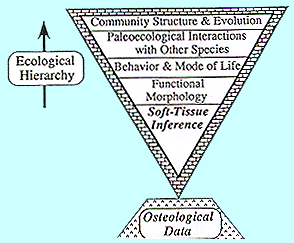
Soft tissues are rarely ever preserved as fossils, but they are very important for a variety of reasons:
1. Soft tissues are largely responsible for the existance, form and maintenance of bones.
2. Judgements about form and action of soft tissues are the basis of a host of inferences.
3. Soft tissue relationships may provide testable hypotheses on the independence or dependence of phylogenetic characters.
The best method of reconstructing soft tissues is the phylogenetic method which uses the first two outgroups of fossil taxon having living representatives as the extant taxa.
Lagerstatten are important in the reconstruction of soft tissues in two ways. Firstly, it is relatively easy to reconstruct soft tissues from fossils in lagerstatten because of the excellent degree of preservation. Secondly, a lagerstatten fossil can sometimes stand in as an "extant" taxon when using the phylogenetic method.

This inverted pyramid of inference shows that inferences about soft tissues are often the basis of many paleobiological inferences. A mistake in soft tissue inference or at lower levels of the pyramid will cascade upwards, amplifying the error.